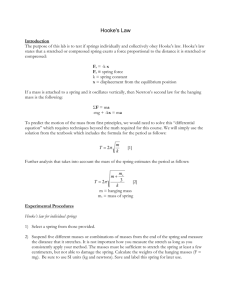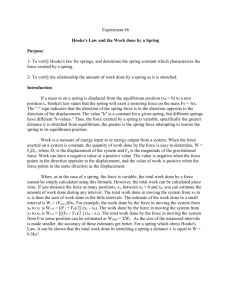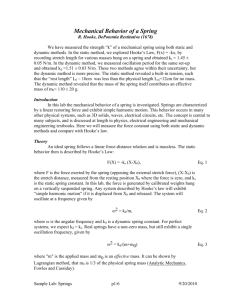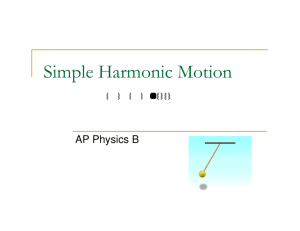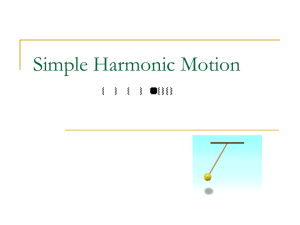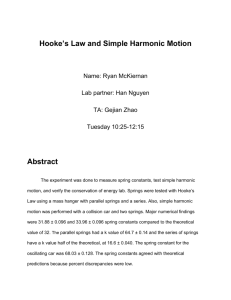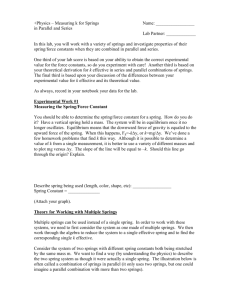Hooks Law
advertisement
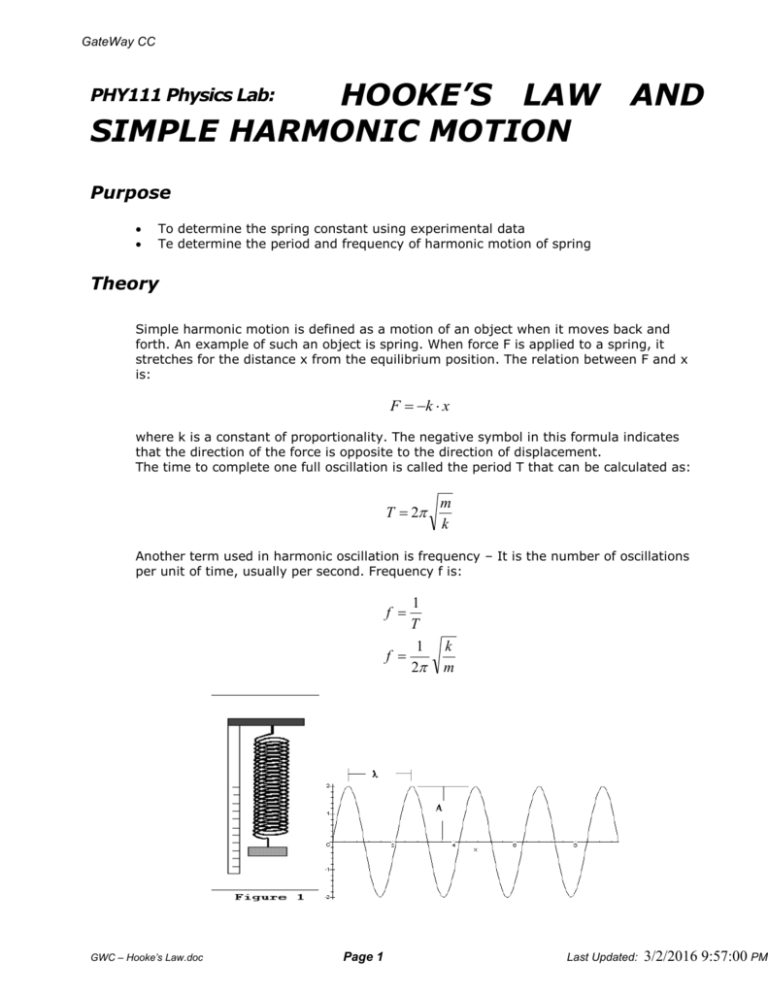
GateWay CC HOOKE’S LAW SIMPLE HARMONIC MOTION PHY111 Physics Lab: AND Purpose To determine the spring constant using experimental data Te determine the period and frequency of harmonic motion of spring Theory Simple harmonic motion is defined as a motion of an object when it moves back and forth. An example of such an object is spring. When force F is applied to a spring, it stretches for the distance x from the equilibrium position. The relation between F and x is: F k x where k is a constant of proportionality. The negative symbol in this formula indicates that the direction of the force is opposite to the direction of displacement. The time to complete one full oscillation is called the period T that can be calculated as: T 2 m k Another term used in harmonic oscillation is frequency – It is the number of oscillations per unit of time, usually per second. Frequency f is: 1 T 1 f 2 f GWC – Hooke’s Law.doc Page 1 k m Last Updated: 3/2/2016 9:57:00 PM GateWay CC Final term that we analyze in the case of harmonic motion is amplitude. Amplitude is the maximum distance that the object is displaced from the stationary position. A typical example of simple harmonic motion is spring. When force (mass on the spring) is applied on string, the spring will be displaced from the stationary position and will oscillate up and down. The force supplied by the spring on the hanging mass is proportional to the displacement. This formula is known as Hooke’s Law. F kx Figure 2. The constant of proportionality k can be found experimentally by applying a known stretching force on the spring and measuring the amount of displacement. k F x Once the proportionality constant is found it can be used to calculate the frequency and the period of oscillation. The equations provided in this lab manual are based on the fact that the mass of the spring itself is ignored. If the mass of the spring is considered, the equation will be modified to take into account the mass of the spring. GWC – Hooke’s Law.doc Page 2 Last Updated: 3/2/2016 9:57:00 PM GateWay CC Procedure Setup the apparatus as shown in Figure 2. Figure 3 1. With no mass attached to a spring, record the position of the spring with reference to a meter stick xo. 2. Hang the mass m = 50 grams on the spiral spring. 3. Calculate the stretching force: F = mg, using g = 9.8 m/s2. 4. Measure and record the new position of the spring with reference to a meter stick xf. 5. Calculate the displacement: x = xf – xo 6. Calculate the spring constant: k F x 7. Calculate the period of oscillation T for each mass on the spring. 8. Calculate the frequency of oscillation f for each mass on the spring 9. Repeat steps 2 through 6 by adding additional 50 g of mass on the spring until the total mass reaches 400 or 500 grams depending on the type of spring that you use. 10. Repeat steps 2 through 9 using two springs in series. 11. Repeat steps 2 through 9 using two springs in parallel. GWC – Hooke’s Law.doc Page 3 Last Updated: 3/2/2016 9:57:00 PM GateWay CC k k k k k M M M Figure 3. Data Table Part I: Calculating the spring constant, period and frequency Objects: Mass hanging on one spring Mass Force Initial Position Xo Kg N m Position Xf Displacement X = Xf - Xo m M Period Frequency sec Hz Constant 0 0.05 0.10 0.15 0.20 0.25 0.30 0.35 0.40 0.45 0.50 GWC – Hooke’s Law.doc Page 4 Last Updated: 3/2/2016 9:57:00 PM GateWay CC Part II: Calculating the spring constant, period and freauency Objects: Mass hanging on two springs in parallel Mass Force Initial Position Xo Kg N m Position Xf Displacement X = Xf - Xo m M Period Frequency sec Hz Period Frequency sec Hz Constant 0 0.05 0.10 0.15 0.20 0.25 0.30 0.35 0.40 0.45 0.50 Part III: Calculating the spring constant, period and frequency Objects: Mass hanging on two springs in series Mass Force Initial Position Xo Kg N m Position Xf Displacement X = Xf - Xo m m Constant 0 0.05 0.10 0.15 0.20 0.25 0.30 0.35 0.40 0.45 0.50 From the data from three tables calculate the average spring constant for each case – one spring, two springs in parallel and two springs in series. The strain potential energy (energy stored while under load) can be calculated by using: GWC – Hooke’s Law.doc Page 5 Last Updated: 3/2/2016 9:57:00 PM GateWay CC EPE 1 Fx 2 Use this formula to calculate EPDE for a Single Spring, for in Two Springs in Series, and for Two Springs in Parallel Part IV: Cumulative table Arrangement Spring Constant (Nm-1) Elastic Potential Energy (J) Single Spring Two Springs in Series Two Springs in Parallel Analysis/Questions 1. Plot a graph of Force (in Newtons) vs. displacement (in meters). 2. Find the slope of the line. What are the units and what does the slope represent? 3. Using your graph, determine the weight of your unknown object from its x. Calculate its mass (F/g). Determine a % error. 4. Which set ahs the highest EPE, and why? 5. Hooke's Law is expressed as F = -kx. What is the meaning of the negative sign? GWC – Hooke’s Law.doc Page 6 Last Updated: 3/2/2016 9:57:00 PM

